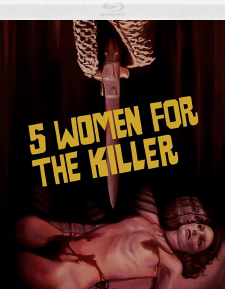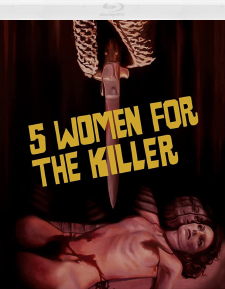Five Women for the Killer (Blu-ray Review)

Director
Stelvio MassiRelease Date(s)
1974 (May 30, 2023)Studio(s)
Les Films de la Boétie/Thousand Cinematografica (Vinegar Syndrome)- Film/Program Grade: B
- Video Grade: B-
- Audio Grade: B
- Extras Grade: B+
Review
Director Stelvio Massi wasn’t necessarily well-known for making gialli, although he did dip his toes into that well on more than one occasion. It doesn’t help that one of his few contributions to the genre, Five Women for the Killer (aka 5 donne per l’assassino), wasn’t successful at the box office and hasn’t really captured the imaginations of giallo fans ever since. Yet it’s a strikingly brutal example of the genre that shouldn’t be overlooked. Massi was no stranger to extremity, with his poliziotteschi films (and others) exhibiting plenty of intense violence. Yet in Five Women for the Killer, the extremity is as much thematic as it is literal. Even without the abundance of blood and viscera on display in the film (and there is plenty of that), it would still be particularly strong stuff. It’s the nature of the story that’s pushing boundaries as much any of the actual acts of violence.
That story was the brainchild of Roberto Gianviti and Gianfranco Clerici, with the final script attributed to Gianviti, Clerici, Vincenzo Mannino, and Jacques Barclay. When reporter Giorgio Pisani (Francis Matthews) returns to Rome after an assignment, his wife dies in childbirth before he can even make it home from the airport, and his premature infant child ends up in critical care. A few days later, he discovers something even more disturbing: he’s actually infertile, so the baby can’t be his. Shortly after that, a string of pregnant women are brutally murdered, with Giorgio as the obvious suspect of the investigation led by an intrepid police commissioner (Howard Ross, aka Renato Rossini). The fact that Giorgio is guilty of infidelities of his own certainly doesn’t help. Of course, Occam’s Razor doesn’t necessarily apply where murder is concerned, and the investigation will uncover some genuinely disturbing truths before it’s over. Five Women for the Killer also stars Pascale Rivault, Giorgio Albertazzi, Katia Christine, and Gabriella Lepori.
Gialli have frequently faced accusations of misogyny, sometimes fairly, sometimes not. The challenge usually lies in drawing a line between the behavior of the characters and the actual perspectives of the filmmakers, but that’s not always easy to do. In some cases those lines are blurred, while in other cases there may be factors that complicate any attempts at classification. With Lucio Fulci, for example, he wasn’t so much a misogynist as he was a misandrist, and his general lack of faith in humanity as a whole was reflected in the behavior of his male characters. That’s an important distinction to keep in mind when watching some of his films like Don’t Torture a Duckling and The New York Ripper. They’re expressions of his feelings about mankind in general—he once told an interviewer, “Hell is already in us.”
In the case of Five Women for the Killer, Massi was actively and intentionally throwing fuel on the misogynist fire. Of course, Fulci ended up doing something similar with The New York Ripper, but there’s no getting around the fact that Five Women for the Killer is particularly strong material in that regard. It’s not just that women are the victims in the film, or even that they’re being killed in a sexualized manner. The motivations that drive the killings and the methodologies that are used are a blatant attack against the nature of femininity and motherhood. It’s the embodiment of a Madonna-whore complex where the lines are blurred between the two stages; maternity itself is seen as the disease. The killer’s knife becomes the penetrative force instead of the penis, and it brings death instead of assisting in the process of creating new life.
That’s not easy material by any stretch of the imagination, but Massi threw himself into it with the same gusto that he applied to the poliziotteschi genre and everything else that he directed. That doesn’t make it any easier to separate the art from the artist in this case. Five Women for the Killer is strong stuff by any metric, so it won’t be for all tastes. Yet for open-minded giallo fans with strong stomachs, it’s an effective (if quite nasty) contribution to the genre that deserves rediscovery.
Cinematographer Sergio Rubini shot Five Women for the Killer on 35 mm film in 2-perf Techniscope using spherical lenses. The 2.35:1 framed image was optically blown up with a 2:1 squeeze applied in order to create anamorphic release prints. This version utilizes a new 4K scan from what Vinegar Syndrome calls a “35 mm archival positive” of the original theatrical cut. Techniscope in the Seventies was sometimes blown up directly from the negative to a Color Reversal Internegative, so the fact that Vinegar Syndrome didn’t actually say this was a scan of an Interpositive means that the restoration probably used a release print instead. There’s a fair amount of damage on display, mostly in the form of speckling, small blotches, and blemishes at the edge of the frame, but there’s also some major damage visible occasionally—for example, there’s two frames at 14:38 that are in particularly bad shape, and there’s some flashing during the opening credits. Shadow detail isn’t always well resolved, with a significant amount of black crush, and there are some density fluctuations as well. The color balance is quite good, though. Given the elements that were involved and the damage that couldn’t be easily dealt with, it’s still a decent presentation of the film. It’s certainly head and shoulders above all other previous home video releases.
Audio is offered in Italian 2.0 mono DTS-HD Master Audio, with removable English subtitles. The dialogue was mostly post-synced, so it doesn’t always integrate well into the soundstage, but that’s the nature of Italian filmmaking in the Seventies. There’s a bit of distortion in the peaks of the raucous score by Giorgio Gaslini, and there’s some audible damage in the track as well, but none of that is too distracting.
Vinegar Syndrome’s Blu-ray release of Five Women for the Killer includes a reversible insert that features new artwork on one side, and the original theatrical poster artwork on the other. There’s also a spot gloss slipcover available directly from Vinegar Syndrome, limited to the first 6,000 units, that was designed by Dani Manning. The following extras are included:
- Audio Commentary with Eugenio Ercolani and Troy Howarth
- My Name Is Howard (HD – 20:11)
- The Massi Tbouch (HD – 24:57)
- Working with Stelvio (HD – 13:24)
- Five Women for a Giallo (HD – 21:42)
- Cinematographers in Arms (HD – 13:29)
- Gore Inserts (Upscaled SD – 1:12)
Film historian and extras producer/director Eugenio Ercolani is once again joined by author and film historian Troy Howarth for this fine commentary track. They feel that Five Women for the Killer has remained relatively obscure despite the presence of recognizable names on both sides of the camera, and they do spend plenty of time delving into the filmographies of many of the cast and crew. Needless to say, Massi is their primary focus, and they trace his career all the way through the problematic turn that he took in the Eighties. They note how the film is more sexually charged than the rest of Massi’s work, and feel that he wasn’t really comfortable with gialli—he was far more interested in violence than he was in sex. While they do tend to get bogged down a bit in qualitative analysis, there’s still plenty of interesting details to be gleaned from this track—Five Women for the Killer has been overlooked enough that there’s not a lot of information about it out there, so every little bit helps.
The rest of the extras primarily consist of interviews and homages to Massi. My Name Is with Renato Rossini, aka the Howard Ross of Five Women for the Killer and The New York Ripper. He talks about his background, how he got into film as both a stunt person and an actor, and his experiences with Massi. The Massi Touch is with Massi’s son Danilo, who worked as an assistant director, second unit director, and occasional writer on his father’s films. He’s quite outspoken, and not necessarily kind to his father’s other collaborators (Rossini lands in his crosshairs at one point). Five Women for a Giallo is with filmmaker Luigi Cozzi, who provides a broad overview of the giallo genre and where Five Women for the Killer fits into it.
Working with Stelvio and Cinematographers in Arms are both “portrait pieces” about Massi. Working with Stelvio features actor Luc Merenda, who describes Massi as both a friend and an adoptive father. He also offers some interesting stories about working with the director. Cinematographers in Arms features cinematographer Roberto Girometti, who recalls his days working with Massi at the Italian newsreel company La Settimana Incom. He says that the cinematographers there frequently served as directors as well, so it was a way of honing both of their skillsets.
Finally, the Gore Inserts are from an alternate version of Five Women for the Killer. While the main feature offers Massi’s original theatrical director’s cut, it was later re-edited with several sequences removed and two brief gore inserts added. That’s the only version that has been available on home video prior to this release. The original film elements for these inserts weren’t available, so they’re presented here sourced from an older VHS version of the film.
The fact that this is the first-ever home video release of the theatrical cut for Five Women for the Killer is a cause for celebration regardless of how you may feel about the film itself. It may not quite be a forgotten giallo, but it is a neglected one, and it’s nice to see Vinegar Syndrome giving it the deluxe treatment in its original form. The video quality is understandably limited by the film elements that were available, but it’s still an upgrade compared to pretty much anything else. The addition of a decent slate of extras never hurts. It’s a recommended release, as long as you’re clear about exactly what you’re getting yourself into.
- Stephen Bjork
(You can follow Stephen on social media at these links: Twitter and Facebook.)

